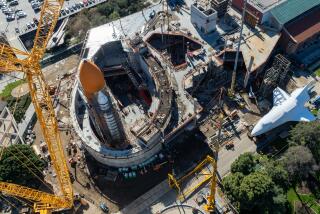Retooled Atlantis Ready to Hitch Ride East
- Share via
PALMDALE — Fresh from a $70-million make-over, the space shuttle Atlantis is scheduled to take off today en route to Kennedy Space Center in Florida--a trip that could be delayed by the anticipated arrival of Hurricane Georges later this week.
Workers at the Boeing Orbiter Major Modification Facility in Palmdale spent Tuesday mounting the 126-ton Atlantis--technically, it’s just the orbiter portion of the whole shuttle--atop a modified Boeing 747 shuttle carrier aircraft.
The aircraft was expected to leave at first light today for a two-day trip to the shuttle launch facility in Florida.
Boeing executives said the shuttle would be kept at a planned stop in Kentucky if the hurricane, expected to reach the Florida area late Thursday or early Friday, becomes a threat.
The Atlantis had been in Palmdale for a tuneup of sorts.
After flying 62 million miles over 20 missions, Atlantis underwent a comprehensive inspection and more than 300 modifications designed to cut maintenance costs, improve shuttle safety and increase its ability to support construction of an international space station.
The Atlantis, with a price tag of nearly $2 billion, and its three siblings are the only reusable passenger-carrying space vehicles currently in existence.
An estimated 350 engineers and technicians--many of whom built the Atlantis--began overhauling the orbiter in November. The most significant improvement was the installation of a state-of-the-art cockpit and a satellite-based navigation system.
The crews also used borescopes, X-rays and ultrasound technology to search for possible fatigue, corrosion, broken rivets or welds.
“It’s held up very well,” said Allen M. Hoffman, the Boeing executive in charge of orbiter modifications. “We occasionally found minor signs of corrosion, but overall the problems have been rather insignificant, given the environment.”
Indeed, according to Hoffman it’s typical for the Atlantis to transition from Florida’s temperate climate to temperatures as low as 274 degrees below Fahrenheit in less than nine minutes. Just 45 minutes later, moving from the dark side of Earth into sunlight, it might face temperatures of 250 degrees Fahrenheit.
To accomplish such feats, the Atlantis’ belly is covered with more than 24,000 black tiles made of a silica material, designed to withstand temperatures of up to 2,600 degrees Fahrenheit.
“The same tiles, however, are so fragile that something like raindrops can damage them,” Hoffman said. “So we try to never fly the orbiter through bad weather.”
Strong winds Monday forced workers to stop “mating” the Atlantis to the 747 shuttle carrier aircraft and postpone the takeoff until today, Hoffman said. With weather conditions permitting, the workers resumed their efforts Tuesday morning to attach the Atlantis to the carrier, using a massive, gray-colored orbiter lifter.
By late afternoon, a specially designed tractor had towed the Boeing 747, with the Atlantis mounted atop it, to the edge of the runway from which it will leave today after a final weather report. The piggybacked pair will be accompanied on their trip by a pathfinder aircraft, which will fly half an hour ahead to monitor weather conditions.
The planes will stop at Ft. Hood, Texas, to refuel and then travel to Ft. Campbell, Ky., for an overnight stay. While in Kentucky, more than 6,500 schoolchildren will get a glimpse of the Atlantis before it continues on to Florida if weather permits, Hoffman said.
The Atlantis is scheduled to launch Aug. 5 on an international space station mission during which it will carry pieces of the proposed station into space and assemble them, Hoffman said. The trip will also allow a team of up to seven astronauts to experiment with protein growths, tissue samples and the manufacture of pharmaceutical drugs in a weightless environment.
More to Read
Sign up for Essential California
The most important California stories and recommendations in your inbox every morning.
You may occasionally receive promotional content from the Los Angeles Times.










